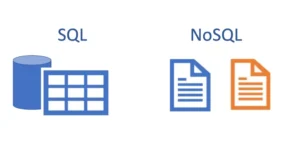NoSQL vs SQL – An Overview
When working with data storage, especially in real-world applications and projects, it’s important to understand the difference between SQL (Structured Query Language) databases and NoSQL (Not Only SQL) databases. Both serve the purpose of data management, but they differ in design, structure, scalability, and use cases.
What is SQL?
SQL databases, also called Relational Databases (RDBMS), store data in tables with rows and columns. They use structured schemas and support ACID properties to ensure data integrity.
Examples:
- MySQL
- PostgreSQL
- Oracle Database
- Microsoft SQL Server
Key Features:
- Structured schema: predefined structure with strict data types and constraints.
- Relational model: tables linked via foreign keys.
- Query language: SQL used for writing and managing queries.
- Transactions: strong support for ACID (Atomicity, Consistency, Isolation, Durability).
Ideal For:
- Applications with structured data
- Systems requiring complex joins
- Financial or enterprise-grade systems needing strong consistency
What is NoSQL?
NoSQL databases are a group of non-relational data storage systems that offer more flexibility and scalability. They are schema-less or have dynamic schemas and are optimized for performance and horizontal scaling.
Types of NoSQL Databases:
- Document-based (e.g., MongoDB)
- Key-Value stores (e.g., Redis, DynamoDB)
- Column-family stores (e.g., Cassandra, HBase)
- Graph databases (e.g., Neo4j)
Key Features:
- Flexible schemas: easy to add/remove fields
- Non-tabular storage: stores data as documents, key-value pairs, graphs, or columns
- Scalability: designed to scale horizontally across servers
- Eventual consistency (instead of strict ACID)
Ideal For:
- Applications with unstructured or semi-structured data
- Real-time analytics, IoT, or big data systems
- Projects needing high scalability and fast development cycles
Comparison Table
| Feature | SQL (Relational DBs) | NoSQL (Non-relational DBs) |
|---|---|---|
| Data Model | Tables with rows and columns | Documents, key-value, graphs, etc. |
| Schema | Fixed and predefined | Dynamic and flexible |
| Query Language | SQL | Varies (MongoDB uses JSON queries) |
| Transactions | ACID compliant | BASE model (eventual consistency) |
| Scalability | Vertical (strong server) | Horizontal (across many machines) |
| Use Case | Structured data, strong integrity | Large-scale, unstructured data |
| Examples | MySQL, PostgreSQL | MongoDB, Cassandra, Neo4j, Redis |
